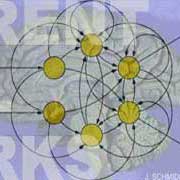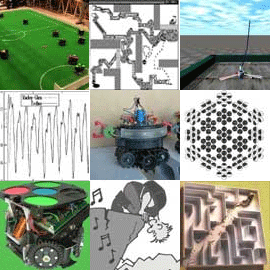| Update January 2010: PhD job filled, Postdoc job (for 1.5 years) open. Prof Jürgen Schmidhuber has an IDSIA PhD fellowship and a Postdoc Job on biologically plausible Reinforcement Learning (RL), in a 3 year Sinergia project with Profs Wulfram Gerstner (EPFL), Michael Herzog (EPFL), Sandi Carmen (EPFL), Walter Senn (Univ. Berne). |

|
We are seeking
outstanding
researchers with experience / interest in topics such as
reinforcement learning (RL),
feedback networks (RNN),
evolution,
adaptive robotics,
curiosity,
unsupervised learning.
Goal: to transform state of the art RL
algorithms (policy gradients, evolutionary methods etc)
into biologically plausible local learning
rules for spiking neurons, and to apply them to artificial agents
such as learning robots, in
collaboration with our partners at EPFL and Berne.
Salary: commensurate with experience; Postdoc ~ SFR 72,000 / year (~ US$ 69,700 / year as of 7 Jan 2010);
PhD student ~ SFR 38,000 / year (~ US$ 36,700). Low taxes.
. |

|
IDSIA is located just outside the beautiful city of Lugano in Ticino (pics), the scenic southern Swiss province. Milano, Italy's center of fashion and finance, is 1 hour away, Venice 3 hours.
Check out some previous IDSIA
postdocs who went on to become profs |
| Submit your CV, a list of 3 references and their email addresses, and a statement of relevant research interests, to cinzia@idsia.ch and juergen@idsia.ch. In the subject header, mention name and job type and keyword sin2008. For example, if your name is Jo Mo and you want the PhD fellowship, use subject: Jo Mo PhD sin2008 |

|
Interviews. Most interviews will take place at IDSIA, but we will also arrange Skype video interviews. We already conducted several interviews at the Singularity Summit in NYC (3-4 Oct 2009) and at the EUCogII meeting in Hamburg (10-11 Oct 2009). And we'll do more interviews at CogSys 2010 (Zurich, Jan 27-28), EUCogII 2010 (Zurich, Jan 29), and at AGI 2010 in Lugano.
Switzerland is a good place for scientists.
It is the origin of special relativity (1905)
and the
World Wide Web (1990),
is associated with 105 Nobel laureates, and
boasts far more Nobel prizes per capita than any other nation.
It also has the world's highest number of publications per capita,
the highest number of patents per capita,
the highest citation impact factor,
the
most cited single-author paper,
the biggest and most expensive machine ever,
etc, etc.
|

|
IDSIA was the smallest of the world's top ten AI labs listed in the 1997 "X-Lab Survey" by Business Week magazine, and ranked in fourth place in the category "Computer Science - Biologically Inspired". IDSIA's most important work was done after 1997 though. IDSIA has strong ties to the TU Munich lab of cognitive robotics at TUM Computer Science. |
|
IDSIA is small but visible, competitive, and influential. For example, its Ant Colony Optimization Algorithms broke numerous benchmark records and are now widely used in industry for routing, logistics etc. (today entire conferences specialize on Artificial Ants). IDSIA is also the origin of the first mathematical theory of optimal Universal Artificial Intelligence and self-referential Universal Problem Solvers (previous work on general AI was dominated by heuristics). IDSIA's artificial Recurrent Neural Networks learn to solve numerous previous unlearnable sequence processing tasks through gradient descent, Artificial Evolution, Reinforcement Learning, and other methods. Research topics also include complexity and generalization issues, unsupervised learning and information theory, forecasting, learning robots. IDSIA's results were reviewed not only in science journals such as Nature, Science, Scientific American, but also in numerous popular press articles in TIME magazine, the New York Times, der SPIEGEL, and many others. |